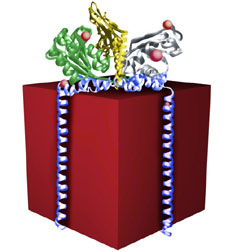
Handy Links
SLAC News Center
SLAC Today
- Subscribe
- Archives: Feb 2006-May 20, 2011
- Archives: May 23, 2011 and later
- Submit Feedback or Story Ideas
- About SLAC Today
SLAC News
Lab News
- Interactions
- Lightsources.org
- ILC NewsLine
- Int'l Science Grid This Week
- Fermilab Today
- Berkeley Lab News
- @brookhaven TODAY
- DOE Pulse
- CERN Courier
- DESY inForm
- US / LHC
SLAC Links
- Emergency
- Safety
- Policy Repository
- Site Entry Form

- Site Maps
- M & O Review
- Computing Status & Calendar
- SLAC Colloquium
- SLACspeak
- SLACspace
- SLAC Logo
- Café Menu
- Flea Market
- Web E-mail
- Marguerite Shuttle
- Discount Commuter Passes
-
Award Reporting Form
- SPIRES
- SciDoc
- Activity Groups
- Library
Stanford
Around the Bay
Happy Holidays
 As 2006 comes to a close and we
enjoy a well earned break over the annual SLAC and Stanford holiday closure, please accept my seasonal greetings to you, your families and loved ones.
As 2006 comes to a close and we
enjoy a well earned break over the annual SLAC and Stanford holiday closure, please accept my seasonal greetings to you, your families and loved ones.
During this time of celebration, I encourage all of you to reflect back on what a momentous year it has been. In the past 12 months, the lab took major steps toward a long term future of continued scientific discovery. The first milestone occurred in March, when a prestigious group of scientists and politicians came together to celebrate the dedication of the Kavli Building. More recently, we celebrated the ground breaking of the Linac Coherent Light Source (LCLS) in the brilliant October sunshine with the help of a number of dignitaries from Stanford, the Department of Energy and our local congressional delegation. LCLS construction is now well underway along the linac, in the research yard and near the collider hall.
The Stanford Synchrotron Radiation Laboratory (SSRL) has had another fantastic year, delivering 96% of scheduled SPEAR3 user beam to more than 1,000 experiments under 345 experimental proposals. SSRL received the green light to begin accelerator operations at up to 500 milliamps of current, opened two new experimental stations to users and achieved first light in the new high-brightness microfocus undulator beamline for macromolecular crystallography. In August, the world's media converged on SSRL as researchers read original Archimedes texts for the first time since antiquity. But the crowning moment was when Roger Kornberg received the 2006 Nobel Prize for Chemistry based significantly on measurements he made on SSRL’s macromolecular crystallography beamlines.
Particle physics also continues to excel at the lab. PEP-II attained record luminosities before being shut down for upgrades in mid-August, and accelerator research continues to flourish. BaBar reached a major milestone when the collaboration published its 200th paper and issued a record number of papers at this past summer's ICHEP conference. The collaboration also achieved conclusive five-sigma results on a new form of CP violation, offering the most sensitive avenue yet for exploring matter–antimatter asymmetries.
The Kavli Institute for Particle Astrophysics and Cosmology (KIPAC) is producing world-class science. Notable in 2006 were Marusa Bradac's conclusive observations of dark matter and Steve Allen's discovery that black holes are the most fuel-efficient engines in the universe. Also this year, the Large Area Telescope (LAT) was shipped to Washington, DC, where it underwent final testing. The instrument is now installed in the Gamma-ray Large Area Space Telescope (GLAST) satellite, nearly ready for its fall 2007 launch date.
The remarkable experiments conducted with the Sub-Picosecond Pulse Source (SPPS) in the Final Focus Test Beam (FFTB) concluded in March to make way for LCLS construction. In the FFTB, exceptionally short bunches of electrons could be used for experiments and also turned into ultrafast pulses of x-ray light. These short pulse x-rays were used to observe a previously unseen world where atoms in materials move too quickly for synchrotron x-ray beams and the dimensions are too small for ultrafast visible light lasers. During the final run, one set of experiments used the short electron pulses to accelerate electrons on a plasma wake. The researchers achieved the highest acceleration gradient ever recorded at SLAC.
What a great year 2006 has been! This outstanding year of science would not have been possible without each and every one of you. I thank you for your hard work and dedication. I also want to acknowledge the essential support and stewardship provided by the Department of Energy and our other Federal sponsors. Let's all look forward to an exciting and successful 2007.
Happy Holidays!
—Keith